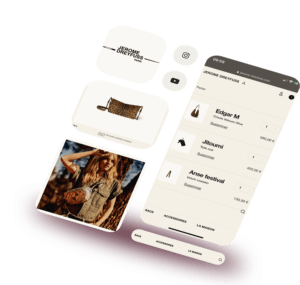Today’s customers crave personalized experiences, especially on their mobile devices. They expect tailored content, product recommendations, and offers across all digital touchpoints, making personalization a key strategy for businesses to stand out and build lasting relationships with their clientele.
A headless architecture is a concept that decouples the front-end presentation layer from the back-end commerce functionality. It enables businesses to create flexible, mobile-optimized storefronts that are capable of delivering these in-demand personalized experiences seamlessly across shopping devices.
Discover how headless commerce empowers you to create unique, mobile-optimized storefronts that drive customer engagement and boost sales.
The Power of Personalization
Personalized shopping experiences are pivotal in enhancing customer engagement and loyalty. By tailoring online interactions to individual customers’ preferences, behaviors, and demographics, businesses can create a more meaningful and relevant shopping journey. This level of personalization not only improves customer satisfaction but also boosts conversion rates, increases average order value, and drives repeat purchases.
Monolithic e-commerce platforms, like Magento or Salesforce Commerce Cloud, struggle to deliver the dynamic and personalized experiences customers expect today. Their rigid structure limits control over content and slow update cycles make it difficult to adapt to changing needs and preferences. This lack of agility creates a disconnect with customers, impacting engagement and potentially driving them away. Furthermore, the limitations on personalization restrict real-time content adjustments and unique experiences, making it difficult to keep pace with evolving customer demands for dynamic and tailored interactions throughout the shopping journey.
Benefits of Headless Commerce for Personalization
Headless commerce unlocks advanced personalization strategies by separating the presentation layer from business logic. This flexibility allows for faster updates, better scalability, and granular control over the user experience. Businesses can experiment with UI/UX designs, create personalized content, and leverage APIs for real-time data exchange. For instance, a mobile storefront can utilize APIs to analyze browsing history and past purchases, dynamically recommending running gear or accessories based on a user’s interest in running shoes. This level of personalization, facilitated by headless commerce and APIs, increases user engagement and conversion rates by presenting relevant products tailored to individual needs.

Revolutionize Your SFCC Experience with Headless Commerce
Creating Unique Customer Journeys
Headless commerce unlocks personalized experiences through dynamic recommendations and contextual messaging. Real-time data allows businesses to suggest relevant products based on browsing behavior and preferences, while contextual messaging offers personalized promotions or location-based notifications. These techniques not only elevate engagement but also tailor the customer journey. Additionally, the modular “composable architecture” of headless commerce empowers businesses to build unique journeys. By integrating specialized services, businesses can adapt to trends, experiment with new technologies, and scale efficiently. This flexibility translates to exceptional digital experiences that align with customer expectations and drive growth.
Mobile Optimization
The rise of mobile commerce necessitates mobile optimization for a seamless shopping experience. With smartphones as the primary access point for online content, businesses must prioritize mobile-friendly websites and storefronts. Responsive design, fast loading times, and user interfaces optimized for smaller screens are non negotiable. Headless architecture empowers this by decoupling the frontend from backend functions, allowing businesses to build custom mobile-first storefronts. This ensures faster loading, intuitive navigation, and a smooth experience for mobile users. Additionally, mobile optimization benefits SEO as search engines prioritize websites with positive user experiences, including those optimized for mobile. By aligning with these algorithms, businesses can improve search engine rankings and drive more organic traffic. In essence, mobile optimization enhances user experience while simultaneously boosting SEO performance.
Implementing Personalization with Headless Commerce
When implementing personalization with headless commerce, leveraging customer data platforms (CDPs) emerges as a best practice. CDPs serve as centralized repositories for customer data from diverse sources, including CRM systems, e-commerce platforms, and marketing tools. By consolidating this data into unified customer profiles, businesses can develop a comprehensive understanding of each customer’s interactions, preferences, and purchase histories. Integration of CDPs with headless commerce platforms facilitates seamless delivery of personalized experiences across all touchpoints, ensuring consistent engagement and relevance for customers.
By harnessing insights from the various touch points, businesses can gain a deep understanding of individual preferences, behaviors, and purchase history. This data forms the foundation for segmentation, allowing for more targeted marketing campaigns, personalized product recommendations, and tailored content delivery.
Through A/B testing and iterative optimization businesses can gather invaluable insights into what resonates most effectively with their audience and refine their user experience to an even higher level. This approach, driven by insights from A/B testing and performance metrics, enables continuous personalization strategies to boost customer engagement and drive conversions.
Case Studies and Success Stories
Jerome Dreyfuss, a luxury handbag retailer, achieved complete UX freedom by adopting a headless architecture with Front-Commerce. By decoupling their frontend from the backend, Jerome Dreyfuss gained the flexibility to design and deliver unique and immersive user experiences tailored to their brand identity and customer preferences. With Front-Commerce’s headless solution, Jerome Dreyfuss seamlessly integrated their existing backend systems with a modern React frontend, enabling rapid development cycles and effortless scalability. By leveraging Front-Commerce’s composable storefront approach, Jerome Dreyfuss transformed their e-commerce platform, delivering a personalized and engaging shopping experience that resonates with their discerning clientele.

Benefits:
- Faster Redesign: By decoupling the front-end, Jerome Dreyfuss achieved a quicker UX refresh without waiting for backend updates.
- Improved User Experience: The new front-end delivered a smoother, more brand-consistent user experience, ready to be personalized.
- Mobile Optimization: The solution ensured a seamless and responsive experience on mobile devices, crucial for today’s mobile-first shoppers.
- Complete UX Freedom: The headless architecture allowed for complete creative control over the front-end design without backend constraints.
- Future-Proofing: The separation of front-end and back-end facilitates future upgrades to the backend system (Magento 2) without impacting the front-end experience.
This example showcases the potential of headless architecture in enhancing UX freedom, personalized experiences, and driving business growth in retail. Read the entire case study, including diagrams explaining their migration process and new e-commerce architecture.
Access Live Demos
Take the first step towards unlocking growth and innovation by exploring headless commerce firsthand with our interactive demos. Get a feel for the seamless user experience and lightning-fast performance that define modern e-commerce. Whether you’re a digital agency, B2C retailer, or B2B merchant, our demos showcase the potential of headless commerce for your business.
Headless commerce unlocks personalized experiences through dynamic recommendations and contextual messaging. Real-time data allows businesses to suggest relevant products based on browsing behavior and preferences, while contextual messaging offers personalized promotions or location-based notifications. These techniques not only elevate engagement but also tailor the customer journey. Additionally, the modular “composable architecture” of headless commerce empowers businesses to build unique journeys. By integrating specialized services, businesses can adapt to trends, experiment with new technologies, and scale efficiently. This flexibility translates to exceptional digital experiences that align with customer expectations and drive growth.

